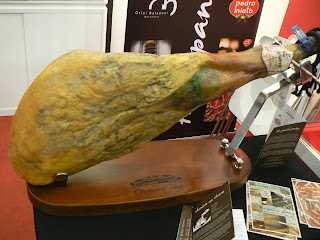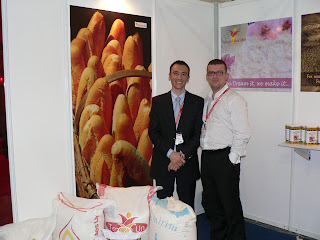 My prized catch of green Indonesian coffee from 4 different regions
My prized catch of green Indonesian coffee from 4 different regions Joseph Grenier's loaves baking in the Wachtel oven
Joseph Grenier's loaves baking in the Wachtel oven Joseph Grenier in action
Joseph Grenier in action French baker from a Vietnamese flour mill
French baker from a Vietnamese flour mill Baguette shaping in progress
Baguette shaping in progress Rolling the baguette
Rolling the baguette The baker from Ireks shaping baguettes
The baker from Ireks shaping baguettes Pre-shaped Baguette dough resting in a tray
Pre-shaped Baguette dough resting in a tray Miche from the same baker
Miche from the same bakerFHA 2010-Part 2
I was fortunate to be able to attend FHA for the entire 4 day event. Here is the second installment, focusing on my 2 loves, bread and coffee. I had a first hand look at how a baguette was shaped by the baker from Ireks. Unfortunately, the bakers were often very busy and it was not possible to talk to them at length. However, a picture speaks a thousand words and just seeing them in action spoke volumes. I was happy that they were willing to share about the composition of the flours used in the breads that they were baking. It seems that they almost never use pure white flour.
Coming to my second love, coffee. I got myself a stash of green Indonesian coffee. 4 types were available at the booth that I visited. They were all organic grade 1 coffee from Lintong, Gayo, Timor and Toraja. I am looking forward to roasting them since nothing beats freshly roasted coffee. My experimental batch of Brazillian Santos coffee given to me by a kindly gentleman. He is a coffee expert whose whole life revolved around coffee and has been in the business for decades after learning from a Dutch Master Roaster. I gave a batch to my good friend and colleague and his comment was that he liked the beans because there was no harsh burnt note in them.
I fell in love with Indonesian coffee after trying out Mandheling and Toraja coffee. All these beans have interesting stories to tell but it is the full bodied richness of the coffee made from these beans that gets one hooked. So when I chanced upon a booth offering green Indonesian, I was delighted and they were equally happy that I had brought my trolley on the last day to scoop off my babies. This was because they came to the trade show without a trolley and the boss had to lug the 60kg of beans and spices as the rest of the staff were petite ladies.



























